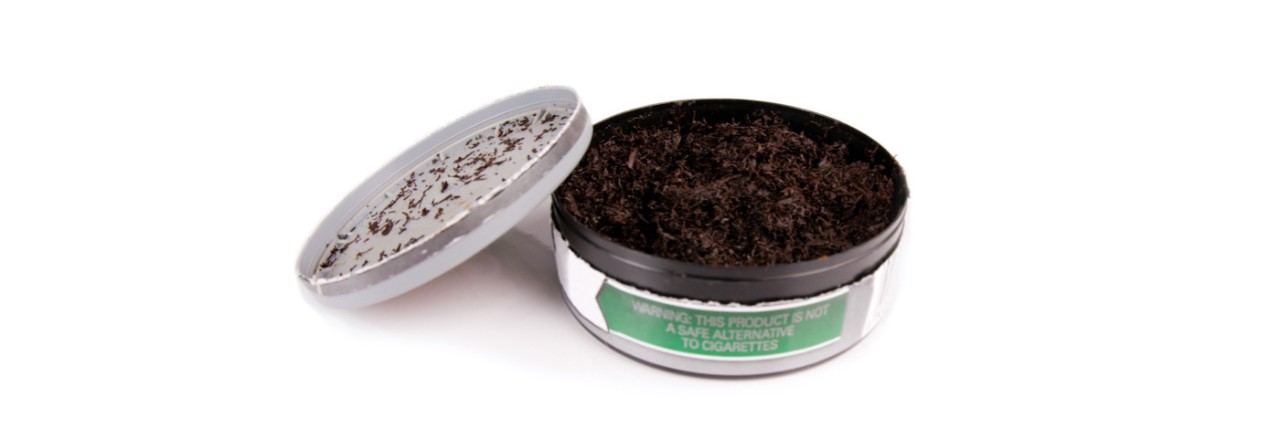It may be smokeless, but it’s still tobacco

Using tobacco can harm your health, including your teeth and gums, in several ways: from tooth discoloration and gum disease to throat, lung and oral cancer and, ultimately, death.
What is “smokeless” tobacco?
Smokeless tobacco comes in different forms and is called by different names, including “spit tobacco,” “chewing tobacco,” “dip” or “snuff.”
One of the newest forms of smokeless tobacco that’s gaining popularity in America is called snus (rhymes with “goose”). It's a Swedish type of smokeless tobacco that comes in teabag-like pouches that a user sticks between their upper lip and gum for up to 30 minutes and discards without spitting. This form of smokeless tobacco has become more popular because it’s not as messy as chewing tobacco, dipping tobacco and moist snuff, which often cause excess saliva during use. It does, however, still contain the active ingredients of chewing tobacco.
Smokeless tobacco and oral health
Just because chewing tobacco and other forms of smokeless tobacco aren't smoked like cigarettes doesn’t mean they’re harmless, especially when it comes to your oral health. Smokeless tobacco users can experience:
- Bad breath
- Teeth discoloration
- Decreased sense of smell and taste
- Greater risk of developing cavities
Like cigarettes, smokeless tobacco can lead to higher incidences of oral cancer. Other known health dangers of smokeless tobacco include:
- Smokeless tobacco products, just like cigarettes, contain at least 28 cancer-causing chemicals.
- Smokeless tobacco is known to cause cancers of the mouth, lip, tongue and pancreas.
- Users also may be at risk for cancer of the voice box, esophagus, colon and bladder, because they swallow some of the toxins in the juice created by using smokeless tobacco.
- Smokeless tobacco can irritate your gums, causing gum (periodontal) disease.
- Sugar is often added to enhance the flavor of smokeless tobacco, increasing the risk for tooth decay.
- Smokeless tobacco typically contains sand and grit, which can wear down teeth, causing tooth sensitivity and erosion.
Warning signs
The most common sign of possible cancer in smokeless tobacco users is leukoplakia, a white, scaly patch or lesion inside the mouth or lips, common among many smokeless tobacco users. Red sores are also a warning sign of cancer. Often, signs of precancerous lesions are undetectable. Dentists can diagnose and treat such cases before the condition develops into oral cancer. If a white or red sore appears and doesn't heal, see your dentist immediately.
What you can do
The best thing you can do for your oral health is to stop using smokeless tobacco. Your dentist can help you kick your smokeless tobacco habit.
If you’re a user of smokeless tobacco, you should understand that tobacco dependence is a nicotine addiction disorder. There are four aspects to nicotine addiction: physical, sensory, psychological and behavioral. All aspects of nicotine addiction need to be addressed to break the habit. This can mean that tobacco users may need to try several times before they are able to successfully kick the habit.
Your dentist may prescribe any of a variety of nicotine replacement therapies, such as a transdermal nicotine patch or nicotine gum. Nicotine patches are worn for 24 hours over several weeks, supplying a steady flow of nicotine. Over the course of treatment the amount of nicotine in the patch decreases. Nicotine gum is slowly chewed every one to two hours. Each piece should be discarded after 20 to 30 minutes.
Smokeless tobacco users may need to see their dentist more often to make sure a problem doesn't develop. Studies have found that 60 to 78 percent of daily users of spit tobacco have oral lesions. A dentist can detect these lesions with an oral examination and will be able to determine a course of treatment.
Last updated April 1, 2022
Related articles:
The oral health information on this website is intended for educational purposes only. Always consult a licensed dentist or other qualified health care professional for any questions concerning your oral health.


